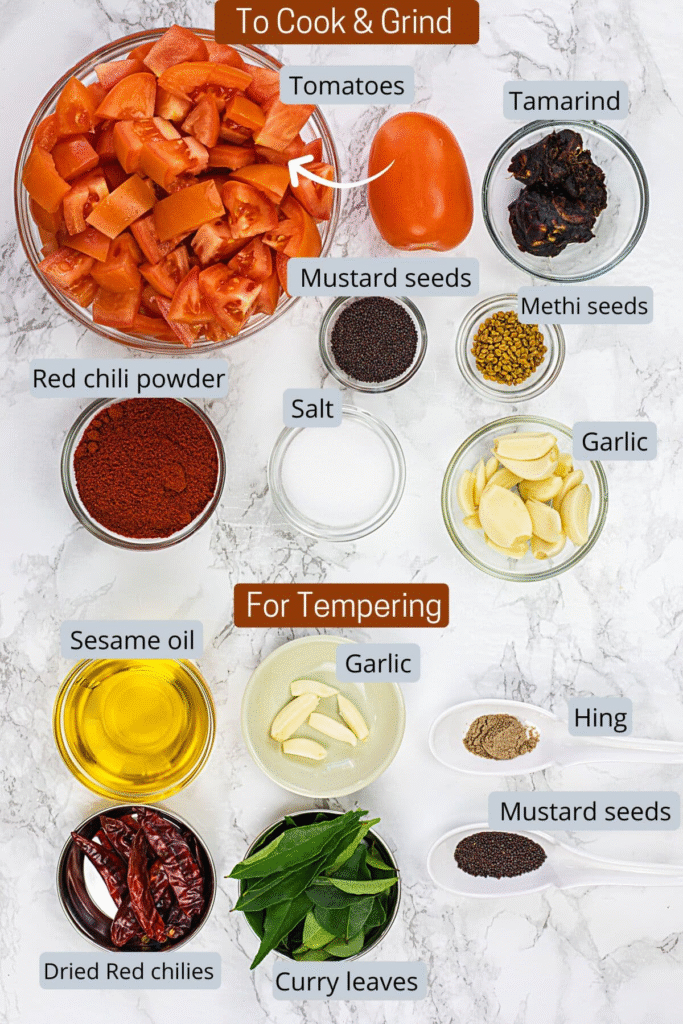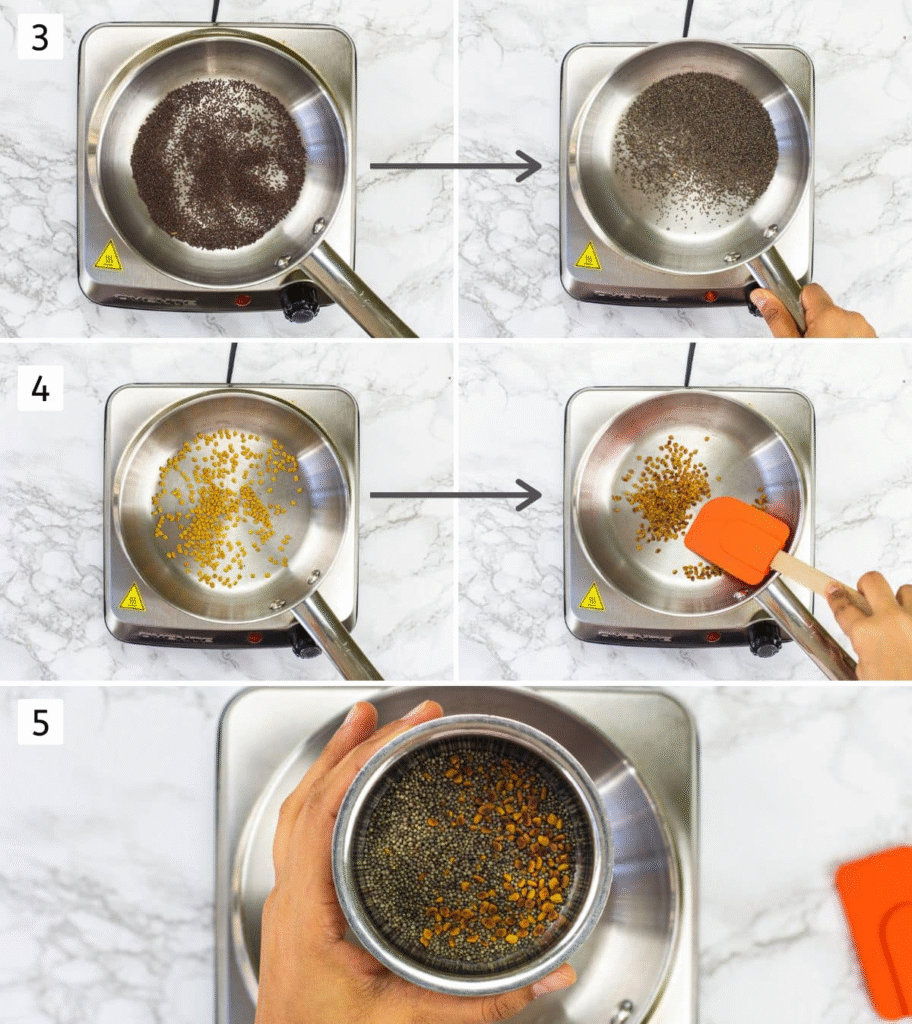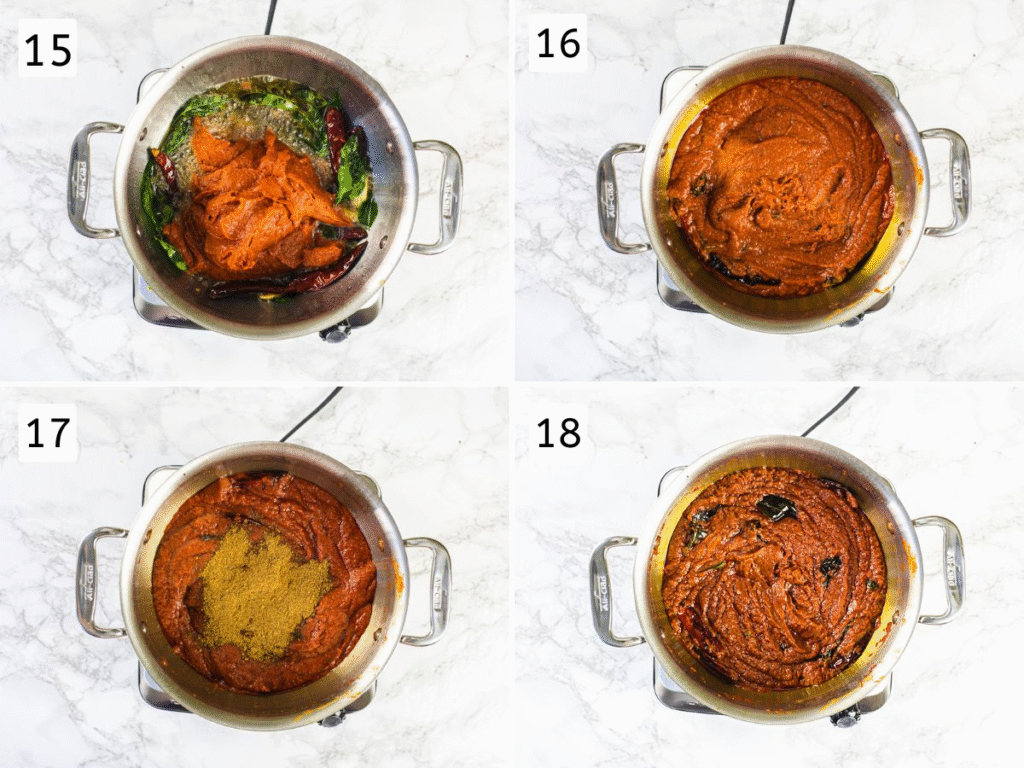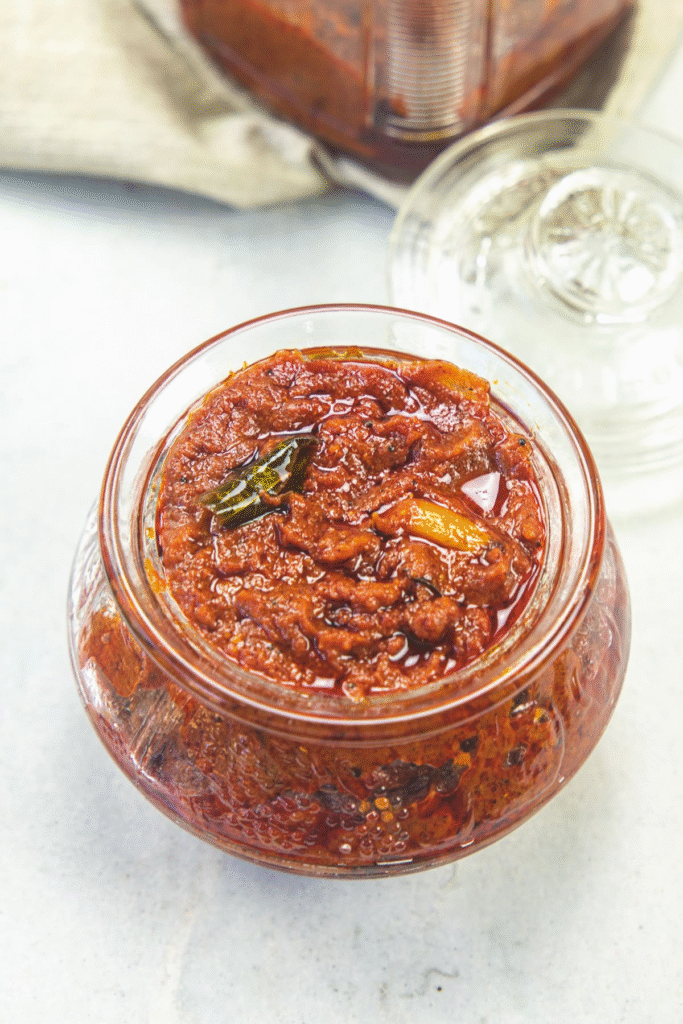This is a simple yet incredibly flavorful Andhra-style tomato pickle recipe that captures the essence of authentic South Indian cuisine. Packed with bold, tangy, and spicy flavors, this fiery condiment is infused with the richness of ripe tomatoes, aromatic garlic, and traditional Indian spices. It’s a versatile side dish that pairs beautifully with a wide range of meals—whether it’s soft idlis, crispy dosas, comforting pongal, creamy curd rice, steamed plain rice, or even with rotis and parathas. Every spoonful bursts with vibrant taste, making it a must-have in any Indian kitchen.

❤️ You’ll Love This Tomato Pickle Recipe
This instant tomato pickle recipe is a time-saving, hassle-free version of the traditional Andhra-style pickle, perfect for those who crave bold flavors without the long wait. Unlike the classic method, which involves laboriously sun-drying tomatoes over several days, this version is cooked quickly by simmering ripe tomatoes with tangy tamarind, spicy red chilies, fragrant garlic, and a handful of traditional spices. Once the mixture is reduced to a thick and luscious consistency, it’s blended into a rich paste and finished with a sizzling tempering of mustard seeds, curry leaves, and asafoetida.
Why You’ll Love It:
- Instant Gratification: This tomato pickle comes together in just about 45 minutes from start to finish—perfect for busy weekdays or last-minute cravings.
- Robust Flavor Profile: It bursts with bold South Indian flavors—spicy, tangy, garlicky, and deeply savory with a well-balanced kick.
- No Sun-Drying Needed: Skip the multi-day drying process. This modern shortcut gives you traditional taste in a fraction of the time.
- Customizable Quantity: Whether you’re cooking for a family or just yourself, the recipe is easily scalable.
Pair it with steaming hot rice, soft idlis, crispy dosas, or even parathas—it adds an irresistible zing to any meal. This pickle also keeps well in the refrigerator, making it a perfect make-ahead condiment for all your meals.
🧾 Ingredient Notes

Tomatoes:
- When choosing tomatoes for making pickles, it is best to opt for Roma or Plum varieties. These types are known for their firm flesh and lower water content, which helps in achieving a thick, flavorful pickle without excess moisture. Avoid using beefsteak tomatoes or those typically used in salads and sandwiches, as these tend to have a higher water content, making the pickle runny and less concentrated in taste.
- Additionally, always pick tomatoes that are fully ripe and have turned a vibrant red color. Using unripe or green tomatoes can lead to a more sour and less balanced flavor in your pickle. The natural sweetness and acidity of ripe tomatoes contribute to the ideal tangy yet savory taste. Therefore, selecting tomatoes that are at their peak ripeness ensures a better texture and a richer flavor profile for your final pickle.
Tamarind:
- Seedless tamarind is utilized to make things simple. If your tamarind is not seedless at that point you require to evacuate the mash by dousing it in water. That includes one additional step.
- Tamarind gives a tart taste as well as acts as a additive to increment rack life.
- Mustard seeds & Fenugreek seeds: Both are dry broiled and powdered, at that point included into the pickle for the signature pickle flavor.
- Garlic: Few cloves are ground into a paste along with cooked tomatoes. Additionally, a few cloves are included to hot oil for tempering.
- Red chili powder: This makes the pickle fiery. You can alter the sum as per your favored zest level. The given sum underneath makes pickle medium spicy.
- Salt: acts as a additive as well as brings out the pickle flavor.
- Sesame oil (gingelly oil): In South Indian pickle recipes sesame oil is utilized whereas in North Indian pickles mustard oil is used.
- Curry takes off: It includes a decent flavor and smell to the pickle.
Also, dried red chilis, mustard seeds, and hing are utilized in hardening tomato pickle.
👩🍳 How To Make Tomato Pickle? (Stepwise)
1) Take chopped tomatoes and seedless tamarind in a huge dish. Turn the warm on to medium.
2) Cover it and cook until tomatoes are delicate and soft and most of the dampness is evaporated.

While tomatoes are cooking, let’s make mustard powder and methi powder.
3) For that, take mustard seeds in a little skillet and dry broil them on medium-low warm until they begin to splutter. Moreover, you’ll take note that mustard seeds get lighter in color. Evacuate it to a bowl and keep it aside.
4) In the same dish, dry broil the methi seeds until they turn light brown in color.
5) Expel it to the same bowl and let it cool down totally.

6) Whereas these two seeds are cooling, go back to the tomatoes. You can see this in picture 6. Tomatoes are delicate and soft, but it has a part of water cleared out.
7) Keep cooking until all the water is gone and the blend gets to be a thick paste. Let the blend cool down slightly.
8) Exchange the cooked tomato-tamarind blend into the processor. Include salt, red chili powder and garlic cloves.
9) Make a smooth paste without including any water. If required scrap the sides and crush once more.

10) Back to simmered seeds. once cooled, pound into a fine powder utilizing a zest processor (coffee grinder).

11) To make a hardening, warm oil in a large pan. Once hot include mustard seeds and let them splutter.
12) Include garlic cloves and saute for a minute.
13) Include dried red chilies and curry takes off, and promptly cover the container with a lid to dodge oil spluttering mess since of curry takes off. Sear until curry clears out are browned well.
14) Include hing.

15, 16) Quickly include arranged tomato paste and blend well.
17) Include arranged mustard and fenugreek powder.
18) Blend and cook for 4-5 minutes with blending every so often or until oil begins to overflow out.

💭Expert Tips
- In case your tamarind is not seedless, you’ll need to prepare it before using. Soak the tamarind in warm water for about 15–20 minutes until it softens. Once softened, use your hands to squeeze and extract the thick pulp, then strain the mixture through a fine mesh to remove any fibers or seeds. This smooth pulp can be added to the tomatoes when they are halfway through cooking. However, since I used seedless tamarind, I simply added it directly along with the tomatoes during the cooking process and blended it together into a smooth paste.
- Tamarind plays a crucial role in enhancing both the flavor and shelf life of the tomato pickle. Its natural acidity acts as a preservative, helping to keep the pickle fresh for a longer duration without refrigeration. Therefore, it’s important not to skip tamarind or reduce its quantity, as doing so may affect both the taste and longevity of the pickle. Using the right amount ensures a perfect balance of tanginess and preservation.
🥣 Storage & Shelf Life Of Tomato Pickle
- Properly stored, homemade tomato pickle can remain fresh in the refrigerator for up to 5 to 6 months—but only if handled with care and hygiene. Follow the key storage tips below to ensure maximum shelf life and flavor retention.
- Always store the pickle in a clean, dry, and moisture-free glass jar or container. Glass is preferred over plastic or metal, as it does not react with the acidic content of tamarind and tomatoes. Ensure the jar is sterilized in advance—wash it thoroughly with hot water, and allow it to dry completely. For extra precaution, leave it under the sun for at least an hour to eliminate any residual moisture or bacteria.
- Use a dry and clean spoon every time you scoop out the pickle. Introducing even a tiny bit of moisture or contamination can spoil the entire batch. Avoid dipping wet or used spoons into the jar, as that can trigger mold or fermentation.
- If you’ve prepared a large quantity of pickle, divide it into smaller portions. Store the bulk of it in a large airtight jar and transfer a small portion into a separate container for daily use. This prevents repeated exposure to air and handling, which significantly helps prolong the pickle’s life and taste.
- After using the pickle, always seal the jar immediately with a tight-fitting lid and return it to the refrigerator without delay. This simple habit prevents the entry of air, moisture, and foreign particles, all of which can reduce the pickle’s longevity and compromise its flavor.
🍽 Serving Ideas For Tomato Pickle
- Tomato pickle pairs exceptionally well with piping hot steamed rice and a generous drizzle of ghee. The richness of the ghee complements the tangy-spicy notes of the pickle, creating a soul-satisfying and comforting meal that’s both simple and flavorful. This is a classic combination often enjoyed in South Indian households.
- It also makes an excellent accompaniment to curd rice, offering a sharp contrast in taste and elevating the overall flavor profile. The tang of the pickle cuts through the creaminess of the curd, making each bite delightful.
- This pickle is incredibly versatile and can be served as a flavorful side dish with South Indian breakfast items such as idli, dosa, uttapam, pongal, and paniyaram. The spicy-sour punch of the pickle enhances the mild flavors of these dishes, making them far more exciting.
- In addition to traditional pairings, tomato pickle also works beautifully as a side dish with a wide variety of Indian meals, including roti-sabzi combinations, dal-chawal (dal with steamed rice), and stuffed or plain parathas. Its bold, tangy, and spicy character brings a delightful zing to any everyday meal, making it a pantry essential..

